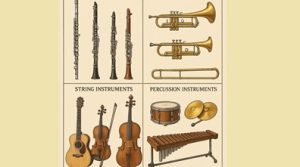Classifications and Types of Musical Instruments
Classifications and Types of Musical Instruments
Welcome to today’s post!

Types of Musical Instruments
We will cover the classification and different types of musical instruments—how they are categorized, their purposes, and examples from both African and international viewpoints.
Let’s get started!
Introduction to Musical Instruments
Musical instruments are the instruments or devices that produce musical sounds. They have their applications in different functions, such as:
- Entertainment
- Accompaniment to dances and rituals
- Spiritual activities and worship
African musical instruments are part of communal life, expressing culture and tradition.
Classifications of Musical Instruments
Internationally, different classification systems for musical instruments exist. These are generally based on how sound is produced. The most popular systems are:
1. The Hornbostel–Sachs System (Internationally Utilized, Especially in Ethnomusicology)
This system was created in 1914 by Erich von Hornbostel and Curt Sachs. It is an expansion of the former systems and is what is used most broadly today.
The instruments are classified according to their sound-producing device into four major categories:
A. Idiophones
These instruments produce sound through vibration of the instrument material itself, not with strings, membranes, or outside breath.
- Method of sound production: Vibration on striking, shaking, scraping, or plucking
- Examples: Xylophone, gong, bell, maracas
- African examples: Agogo, slit drum, shekere
B. Membranophones
Sound is produced by a stretched membrane (usually made from animal skin) that vibrates when struck.
- Method of sound production: Striking the stretched membrane with sticks, mallets, or fingers
- Examples: Drums like congas, bongos
- African examples: Gangan (talking drum), gudugudu, gbedu, igba ndi eze.
C. Chordophones
- Sound production: Bowing, plucking, or striking strings
- Examples: Guitar, violin, harp
- African examples: Una, gurmi, goje, molo, kukuma
D. Aerophones
Wind instruments in which sound is produced by air vibration, usually by blowing.
- Sound production: Blowing air across an opening or a reed, ora mouthpiece
- Examples: Saxophone, trumpet, flute
- African examples: Bamboo flute, millet stalk, gourd trumpet, animal horn
Alternative Classification Systems
1. Western (Classical) System
Following ancient Greek tradition and enhanced in the Renaissance:
- Strings: e.g., violin, cello
- Woodwinds: e.g., clarinet, flute
- Brass: e.g., trumpet, trombone
- Percussion: e.g., drums, cymbals
- Keyboard instruments fall into their group (e.g., piano, harpsichord, celesta), as these feature hybrid mechanisms.
Note: Some instruments (e.g., piano) cannot be assigned to this system since they are of a dual type (string and percussion).
2. Chinese Classification System
Another of the older systems, dating back to the 3rd millennium BC. It classifies instruments based on the material with which they are constructed:
- Stone
- Wood
- Silk (for stringing)
- Bamboo (for flutes)
It’s a system linked to natural materials and seasons.
3. Indian System (from the Natya Shastra)
Developed in ancient India, this system classifies instruments based on the method of sound production:
- Tata Vadya (Stringed instruments)
- Susira Vadya (Wind instruments)
- Ghana Vadya (Solid/percussion instruments)
- Avanaddha Vadya (Drums with membranes)
This scheme became the basis for Mahillon’s and subsequently the Hornbostel–Sachs systems.
Conclusion
Musical instruments are just as diverse as the cultures that they serve.
From the Western European violin to the West African talking drum, every instrument of its kind has a unique role to play in musical expression.
In grouping them, we not only know how the instruments work, but also about each’s history and culture.
Now that you understand the four broad categories—idiophones, membranophones, chordophones, and aerophones—are you aware of some from your music of choice or local community?

Questions and Answers
- Q: What are musical instruments?
A: Musical instruments are devices intended to produce musical sounds for purposes such as entertainment, worship, dance accompaniment, and rituals. -
Q: What are the four main categories of musical instruments in the Hornbostel–Sachs system?
A: The four broad categories are:
- Idiophones
- Membranophones
- Chordophones
- Aerophones
-
Q: Define an idiophone. Give two examples.
A: Idiophones are those instruments that produce sound by vibrating themselves without strings, membranes, or air.
Examples: Xylophone, Agogo -
Q: Explain how membranophones produce sound. Give two African examples.
A: Membranophones sound when the animal’s hide or membrane, which has been stretched, vibrates.
Examples in Africa: Gangan (talking drum), Gbedu -
Q: Which musical instrument is a flute, and how does it produce sound?
A: A flute is an aerophone. It produces sound when air is blown across its mouthpiece, causing the air column inside the flute to vibrate.
-
Q: Describe chordophones and give two examples from Africa.
A: Chordophones are musical instruments that sound through vibrating stretched strings.African examples: Molo, Goje
-
Q: On what classification system is the instrument composed of material classified?
A: The Chinese classification system classifies instruments according to material, like stone, wood, silk, and bamboo.
-
Q: What is the main distinction between brass and woodwind instruments in Western classification?
A: Woodwind instruments produce sound with a reed or split stream of air, whereas brass instruments produce sound with the vibration of the player’s lips over a mouthpiece.
-
Q: Why is the piano difficult to classify in the Western system?
A: Because it has strings like a string instrument but produces sound by striking those strings with hammers, similar to a percussion instrument.
-
Q: Name the four categories of instruments according to the Indian (Natya Shastra) system.
- Tata Vadya – String instruments
- Susira Vadya – Wind instruments
- Ghana Vadya – Solid percussion instruments
- Avanaddha Vadya – Membrane-covered drums





